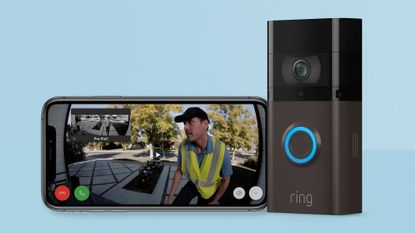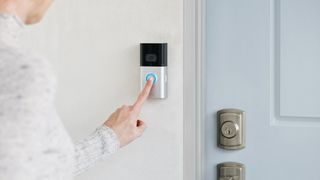Ring Video Doorbell 3 Plus review: the most flexible camera doorbell
The Ring Video Doorbell 3 Plus adds better motion detection, new privacy options, and a clever new Pre-Roll pre-recording feature

The Ring Video Doorbell 3 Plus mixes great physical design and convenience with a good app – but we think its smarts need more developing to keep it on top.
-
+
Video great
-
+
Pre-roll works well
-
+
Flexible installation is welcome
-
+
Great battery life
-
-
Requires subscription for any cloud storage (and no local option)
-
-
More definable motion zones would be welcome
-
-
Lack of Google Assistant integration
Why you can trust T3

Welcome to T3’s Ring Video Doorbell 3 Plus review. This is Ring’s most expensive camera doorbell for regular people, offering the biggest range of features and replacing the Ring Video Doorbell 2 by adding some handy technical upgrades.
Ring has managed to carve itself a place as the go-to smart doorbell, and this new doorbell will help cement that, though as an upgrade it's not without some missed opportunities.
But what you have got here is more comprehensive wireless support, improved motion detection, new privacy options, and a new ‘Pre-Roll Video' feature.
• Best cheap Ring Video Doorbell deals
• Best smart security cameras
• Best smart speakers
There’s nothing game-changing in the new Ring Video Doorbell 3 Plus, but its range of improvements and new tricks keep it as one of the best video doorbells – though the gap between this fanciest Ring and the new cheap £89/$99 model is smaller than it was in the previous models, despite this model being double the price of its little sibling.
And then there’s also the Ring Video Doorbell 3 (without the ‘Plus’) available, to add confusion. Let’s get into what the current line-up looks like, and what you get with each model.
• All-new Ring Video Doorbell (2nd gen) vs Ring Video Doorbell 3
Ring Video Doorbell 3 Plus review: Price & release date
The Ring Video Doorbell 3 Plus was released in April 2020, along side the Ring Video Doorbell 3 (no plus).
The new Ring range looks like this: there’s the more basic All-new Ring Video Doorbell (2nd-gen), which costs £89/$99 (and is released in early June). Then there’s the Ring Door View Cam (for peepholes rather than wall-mounting) at £119/$129. Then you have the Ring Video Doorbell 3 at £179/$199. And finally the Ring Video Doorbell 3 Plus at £199/$229.

Ring Video Doorbell 3 Plus review: Features
Let’s break down the features you get across the standard Ring doorbell range (not including the Door View Cam), because that helps us to understand what each model offers.
The cheapest Ring model includes 1080p Full HD video, motion detection based on infrared (including a new mode specifically for detection motion 5 to 15 feet from the doorbell), 2.4GHz Wi-Fi, night mode, privacy zones than enable you to literally black out what the camera sees in sections of your choosing, two-way talking to people at your door, and the ability to power it by battery or wiring (though for recharging, the whole unit needs to be removed from the wall).
The Ring Video Doorbell 3 adds to that: dual-band Wi-Fi (2.4GHz and 5GHz); the ability to swap battery packs in and out for easier charging; and it comes with more accessories in the box, including a corner mount and wedge mount that can be very useful.
The Ring Video Doorbell 3 Plus is the same as the Doorbell 3, but adds the only new video feature on offer: Pre-Roll Video. This, simply, means that when the camera detects motion or the button is pushed (whatever you have set up to trigger its recording), it not only records the video that follows that trigger, but also offers four seconds of black and white video of what happened before the event.
To make this happen, the camera is basically taking photos regularly like a time-lapse, but in limited quality to reduce the strain on battery life. When motion is detected, it stitches the most recent photos into a little video.
If you’re looking at the feature list above and feeling like the Ring Video Doorbell 3 doesn’t seem to offer much for its higher price then… well, we agree. We can’t imagine deciding to spend the extra £90 over the basic model for basically no video improvement, and then not stumping up the extra £20 for the Plus model.
All Ring Doorbells require a cloud subscription if you want to use them for recording video. Without a subscription, you can receive notifications and see what’s happening live, but you can’t see anything that happened in the past. There’s no option for local storage either, so you either pay Ring £2.50/$3 per month (for a single device, £8/$10 for multiple devices if you get products like the Stick-Up Cam too) or you don’t get the security advantage of being able to see video again.
That’s probably not a problem if you’re buying the cheapest version primarily to be a smart doorbell rather than a security camera too, but if you’re getting this Video Doorbell 3 Plus with a specific extra video feature that’s about capturing additional footage, you’re probably going to wind up paying for a subscription.

Ring Video Doorbell 3 Plus review: Setup
There are two sides to setting up the Ring Doorbell 3 Plus: activation, and installation.
Activating the device proved easy, following the instructions in the app – it takes you through the process of getting it on your Wi-Fi, and the app can walk you through the key settings, including choosing motion detection options such as selecting which motion zones you want it to monitor.
There is a bit of a wrinkle here, which is that the in-app video explaining how Ring’s motion detection zones work shows an older version of the interface, so what’s in the “how-to” guide doesn’t match what you’ll actually need to do. However, the options have been simplified from previous versions, so anyone with an ounce of tech-savvy will still understand what’s going on easily enough.
Installation is also easy, thanks to a lot of thoughtfulness on Ring’s part when it comes to accessories. Not only is everything you need included in the box, but so is a bunch of stuff that might simply be helpful.
It comes with a drill bit that’s the perfect size for the plastic wall anchors that are also included, along with all the screws you could need for the various mounting options it offers. There’s a double-ended screwdriver with a standard cross head end, and an end for the security screw that’s crucial to making the doorbell hard to steal.
For those who’ve wondered about the security of a smart doorbell, it works like this in Ring's case: a mounting plate is secured to the wall with screws. The doorbell is then screwed onto the mounting plate, and the location of these screws is under the lower faceplate of the doorbell. The faceplate is then fitted using a screw with a security head, so someone would need an unusual tool to remove it – the battery pack is also secured in place with this screw.
None of this is exactly unbeatable – various parts are plastic and so can be forced. A screwdriver for the security screw type can be bought easily enough. But most theft is opportunistic, and this system makes the doorbell hard enough to steal that it should stay on your wall.
However, if your doorbell is stolen, Ring gives you one free replacement as part of the company’s standard one-year warranty, which adds some peace of mind. If you have the Ring Protect subscription, that warranty is extended.

Ring Video Doorbell 3 Plus review: App & smarts
The Ring app is an interesting one – overall, it’s really good, and puts the important information up front when you open it (though mostly, you’ll open it from a notification and will be taken straight to video anyway), but there are a few foibles about it that bugged us.
You’ve got a History button, which tells you if new events (such as button presses or motion detection) have happened. This is quite a big white button, with a symbol – it seems like a waste of space not to give a bit more information here. But doing it this way does keep it simple, so we don’t hate it.
Tap on the history button and you get a chronological list of events that have triggered the camera – just scroll down to find one at a particular time, if you’re curious. Ring’s cloud service stores videos for 30 days in the UK, 60 days in the US – to keep something for longer, you can download it your device.
Back to the main screen, and under the History button are your cameras, with recent images from them. If you tap a camera, you get a new view with the option to start watching live, and a kind of timeline of what that camera has seen. This, confusingly, is a horizontal timeline (unlike the History timeline, which is vertical).
It’s a much more in-depth option – you can scrub back through it to see moments when the camera spotted motion, but because the Ring Video Doorbell 3 Plus takes snapshots regularly, you can actually just hit a play button and watch time-lapse footage of the front of your house…
When you find a specific recording, the Pre-Roll section of the video is highlighted slightly differently to the rest.
Tapping the cog in the corner of this screen takes you to the settings screen for that device, which is again sensibly laid out, though some options are harder to find than others – the new privacy feature to block out a section of the screen, touted specifically by Ring as one of the key new features, is buried a couple of menus deep.
Meanwhile, there’s a prominent button for ‘Smart Alerts’ that has a single option in (to only alert you if it detects humans). Why this isn’t included in the ‘Motion Settings’ option alongside every other related control, we don’t know.
A lot of options such as the smart human detection are turned off by default, presumably because they slightly delay how long it takes for motion notifications to be sent to you (while the processing happens). HDR video was also turned off by default to save battery life, for us – when you take the time to dig in, a surprising number of features are both turned off and not located in a super-obvious place.
Still, as we said, these are more foibles than issues – they may not be in an obvious place, but they’re not deeply hidden either.
However, we think the Ring Video Doorbell 3 Plus could do with being a little smarter, particularly when it comes to motion. Human-only notifications is a nice touch (when you find it), and helps to avoid some pointless motion notifications, but we still had a lot of them.
We have a path about 10 feet from our door, and even setting the detection to only detect as close as possible still meant it triggered when anyone went by. Ring suggests using a downward angle mount to help with this, which did work, but also gave us a more awkward view for security.
There’s no option for the more traditional kind of motion zone specifying, where you would draw areas on the screen you want it to ignore – that would have solved our problem totally. The privacy option blocks motion detection, but it also stops you seeing what’s there, so isn’t a suitable fix.
When it comes to working with other smart stuff, the Ring is fairly limited. Obviously a network of Ring devices is all supported within the app, and there’s great Alexa support (unsurprising, since Amazon owns Ring). But no Apple HomeKit, and the Google Assistant support might as well be non-existent.
The app also doesn’t take full advantage of notifications – on iOS, for example, the likes of the Arlo Pro 3 or Netatmo Smart Indoor Camera send you an snapshot of what they see along with a motion notification, which also goes to Apple Watch, with a range of ways to respond. It's useful at-a-glance stuff.
The Ring app gives you some useful ways to respond from its notification, but no snap shot image, which feels very old-fashioned (or, at least, not premium for something at this price).
Between this and the awkward motion zoning, and a lack of other big steps forward in the Ring platform, it does feel a little like Ring is coasting at the moment when it comes to smarts.
Face recognition is a perhaps obvious smart feature that’s missing here, but we’re okay with that, at least right now. Privacy continues to be a big question for smart doorbells, and keeping face recognition out of the equation feels sensible, though we can certainly understand non-invasive reasons people might want it.

Ring Video Doorbell 3 Plus review: Performance
The image quality from the Ring is good – you can see what’s going on perfectly well near your home, and though the wide field of view stretches the resolution, you can make out for things further away. You won’t be able to make out license plates across the road, for example, but it more than does the job.
Our camera was installed facing south and has been getting full sunlight a lot of the time, but even with HDR off (to save battery) everything we needed to make out was perfectly visible. The sky over over-exposed and clipped to white, and turning HDR on fixed that (and showed more accurate colours across the whole frame), but that’s not really necessary for a security camera, so take your pick as to whether you use it or not.
The Pre-Roll footage is interesting, because it’s not only black and white, it’s also a narrower aspect ratio, so doesn’t capture the very top and bottom of the frame. Assuming it’s a person you’re looking for, this isn’t really an issue. It’s also much lower quality – you can make out what’s happening no problem, but you won’t get a perfect mugshot to share with the police.
Motion notifications come in fairly timely fashion – there are various extra detection options (such as the human detection) that Ring says will slow how quickly it tells you about motion, but we’ve found that it’s timely enough not to be an issue even with everything turned on.
Connecting to the camera is fast, even though ours reported having difficulty getting a good connection initially (we went to check later if it was still struggling, and the ‘Signal strength’ part of the app is effectively useless, so that's not ideal). We had no problems with signal strength overall, though.
Ring made a point of mentioning dual-band Wi-Fi as a new feature here, but it’s not that much of a draw for a product like this. Because the signal has to punch through walls, it’s most likely to rely on the 2.4GHz band that was already supported, rather than the faster – but shorter-range – new 5GHz band.
If you really struggle with your doorbell’s Wi-Fi, Ring makes the Chime Pro, which acts as its own Wi-Fi repeater, so you can place the Chime Pro between your router and the door, and your doorbell’s signal doesn’t have to reach as far. The Chime Pro also makes noise when the doorbell is pressed, and optionally when motion is detected at the front (and also acts as a night light). We’ve tried it, and it works well.
In terms of battery life, you should be looking at six weeks to two months minimum, based on our testing – we used about 50% over a four-week testing period, and we have a lot of people moving past the house, causing a lot of motion triggers (and therefore cloud recordings). If you need HDR video on (if your view has both shade and strong sunlight, for example), that could reduce it. If you turn off motion detection totally, you could extend it. In any case, we’re impressed.

Ring Video Doorbell 3 Plus review: Verdict
The Ring Video Doorbell 3 Plus is the best video doorbell you can get right now, because it presents the most accomplished package overall. It’s got the most going on technologically, and comes with every accessory you could need, including the corner and wedge mount.
It’s really simple to set up, the app is intuitive overall, and everything works as promised.
We just about recommend it over the cheaper All-new Ring Video Doorbell for small conveniences such as the swappable battery pack being easier for charging, but we admit that feature plus Pre-Roll Video don't quite feel like £110/$120 of extra usefulness. For most people, the lower-price version is probably the model they'll go for still.
We also think that, when it comes to smarter features and broader flexibility, Ring’s lunch is out on the table at risk of being eaten by an upstart in this area. But that hasn’t happened yet, and this still is the doorbell we’d push the button on.
Upgrade to smarter living
Get the latest news, reviews, deals and buying guides on gorgeous tech, home and active products straight to your inbox.
Matt is T3's former AV and Smart Home Editor (UK), master of all things audiovisual, overseeing our TV, speakers and headphones coverage. He also covered smart home products and large appliances, as well as our toys and games articles. He's can explain both what Dolby Vision IQ is and why the Lego you're building doesn't fit together the way the instructions say, so is truly invaluable. Matt has worked for tech publications for over 10 years, in print and online, including running T3's print magazine and launching its most recent redesign. He's also contributed to a huge number of tech and gaming titles over the years. Say hello if you see him roaming the halls at CES, IFA or Toy Fair. Matt now works for our sister title TechRadar.
-
 Apple Vision Pro 2 still on the cards, could come as soon as next year
Apple Vision Pro 2 still on the cards, could come as soon as next yearThe Vision Pro story is set to continue
By Britta O'Boyle Published
-
 Braun's latest addition to the PowerBlend family is specially designed for those on the go
Braun's latest addition to the PowerBlend family is specially designed for those on the goRushing around in the mornings? Braun's latest launch will help
By Lizzie Wilmot Published
-
 Sore lower back after running? A physio says these three exercises can help
Sore lower back after running? A physio says these three exercises can helpIf you’re prone to back aches after a run, give these a try!
By Bryony Firth-Bernard Published